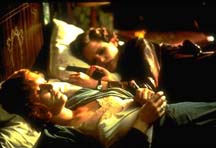
In Her Own Movie: Jennifer Jason Leigh kidnaps laudanum-swilling housewife Miranda Richardson in hopes of exchanging her for her own husband, held captive by a gangster.
In 'Kansas City,' Robert Altman's characters rotate around two peculiar performances
By Richard von Busack
AIMING FOR QUIRK and hitting murk, the mortally flawed Kansas City by Robert Altman is a muddle of noir plotting and slaved-over production design. The two usually fit together badly. When set against buildings that look like an arcade of antique shops, corruption ceases to have much menace. (See Mullholland Falls, Devil With a Blue Dress, et al.)
The film is set in a vague pre-war milieu, probably post-1934 but with streaks of wartime prosperity and wartime music throughout. An ensemble of Robert Altman characters rotate around two extremely peculiar performances. First, there's a nearly unintelligible Harry Belafonte, doing a Brando whisper that recedes out of hearing range. Belafonte is overlapped in Altman's trademark wraparound sound; in fact, he's nearly drowned out by the jazz orchestra playing on the soundtrack. Belafonte plays a gangster called Seldom Seen--"but often heard," wisecracks a young boy (Albert J. Burnes) who will, we are led to believe, grow up to be the legendary jazzman Charlie Parker himself.
Indeed, Altman and co-screenwriter Frank Barhydt must have decided that gangsters of few words were such a cliché that it would be novel to have a gangster who could talk the leg off a chair. Belafonte, fixing his gaze upon no one and everyone, in that gangster style we moviegoers are used to, talks and talks and talks, and you can barely hear what he says over the saxophones. Occasionally a threat, albeit an inane threat ("My mother would have cut your balls off") is audible.
All too audible is Jennifer Jason Leigh. She channeled Jean Arthur in both Mrs. Parker and the Vicious Circle and The Hudsucker Proxy ; here she does an unfortunate Jean Harlow imitation, talking through the corner of her mouth in an acrid drawl. Leigh's acting here is reminiscent of a regular sketch on television's In Living Color, where one of the cast was filmed in scratchy black and white, dressed in imitation Edith Head and depicted talking in the brittle patois of a Warner Bros. dame of the 1930s. As the expression goes, she was in her own movie. Through morphing she was slapped into a 1990s scene for contrast and comedy.
Here Leigh's arch, movieish behavior is played for drama instead of parody. Leigh is Blondie, a half-bright Harlow worshipper who works for Western Union. Blondie kidnaps a laudanum-swilling society housewife named Carolyn (Miranda Richardson), hoping to exchange her for her own husband, Johnny (Dermot Mulroney), currently in the captivity of Seldom Seen. Blondie figures, rightly, that Carolyn's husband, Frank (Michael Murphy), will have political connections with the underworld that will help her bargain for her husband's life.
What must have lured Altman to the project was a chance to present his home town in 1934, which at the time dueled with Chicago for the title of the most corrupt city in America. Machine politics (outlined sketchily here) protected crime lords and political bosses alike. There was a flower rooted in this swamp, however. The bars downtown on Vine Street, not subject to liquor laws and closing times, were the background of an unusually rich musical landscape, hosting jam sessions by the main names in jazz and blues.
Big Joe Turner--who always maintained there was no difference between jazz, blues, R&B and rock & roll--was there in real life when all four met in Kansas City music. There is a singing bartender in Kansas City, which Turner was, though the vocalist here sounds much more like Louis Jordan. (Too bad Altman doesn't have an actor playing Julia Lee. Highly recommended, music lovers.)
Kansas City's best moment is a cutting session--a KC style musical contest--between actors playing Coleman Hawkins and Lester Young. Watching reverently from the balcony at the Hey Hey Club, Altman's fictional nightspot, is the young Charlie Parker--later to play these same clubs shortly before the Bird flew to midtown Manhattan, where the trail of Kansas City jazz disappeared into the mystifying labyrinth of bebop.
A movie about music that was all about the fury of living ought to have some fury itself, but Kansas City is a glum and sour picture. Altman usually finds a balance between the dire and the comic, but this film is dire enough to erase the most elementary dramatic tension. Brooke Smith and Steve Buscemi, looking when they arrive as if they were comic relief, turn in for their portion of horror. The film is situation tragedy, positing that the government is corrupt and the gangsters are more corrupt, and the two are in bed together, and the little guy is just going to end up shot or cut up. The erstwhile realistic conclusion, more like Hammer Studios than Dashiell Hammett, is a punchline to one great distempered mess.
Kansas City, directed by Robert Altman, written by Altman and Frank Barhydt, photographed by Oliver Stapleton, and starring Jennifer Jason Leigh, Miranda Richardson and Harry Belafonte.
[ Metro | Metroactive Central | Archives ]
